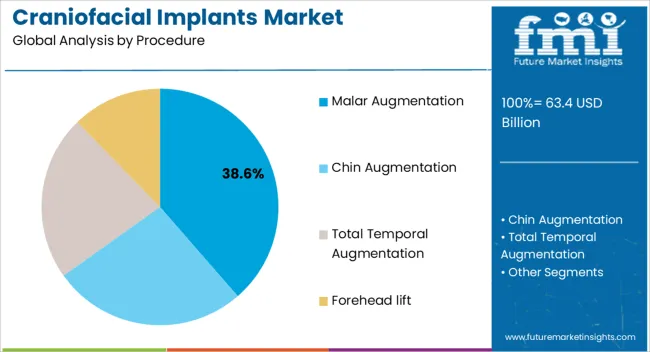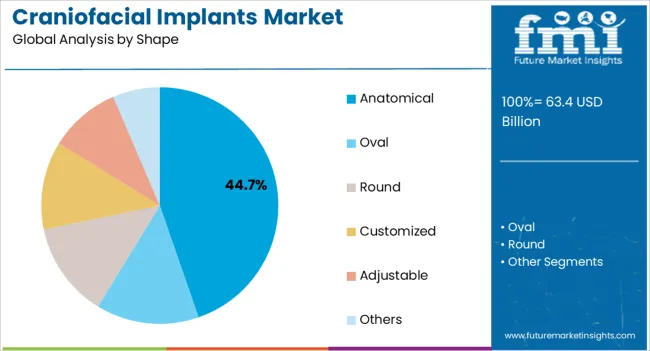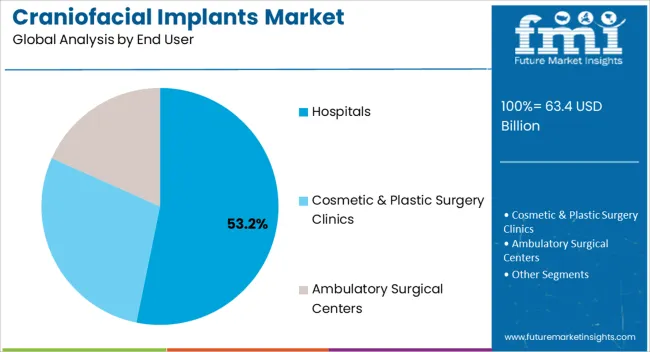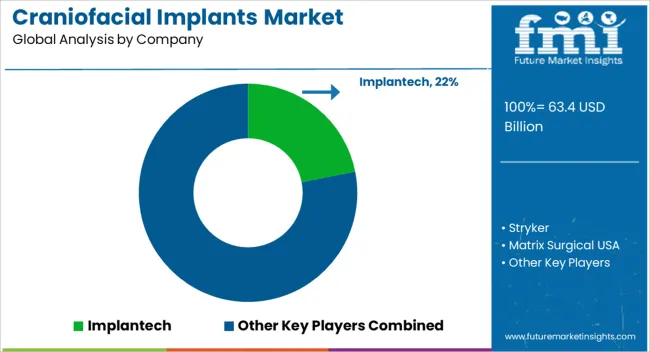The Craniofacial Implants Market is estimated to be valued at USD 63.4 billion in 2025 and is projected to reach USD 129.0 billion by 2035, registering a compound annual growth rate (CAGR) of 7.4% over the forecast period.

| Metric | Value |
|---|---|
| Craniofacial Implants Market Estimated Value in (2025 E) | USD 63.4 billion |
| Craniofacial Implants Market Forecast Value in (2035 F) | USD 129.0 billion |
| Forecast CAGR (2025 to 2035) | 7.4% |
The craniofacial implants market is experiencing steady growth owing to the rising prevalence of congenital facial deformities, trauma cases, and the increasing adoption of advanced reconstructive procedures. Technological innovations in biomaterials and 3D printing have significantly improved the design and precision of implants, ensuring better patient outcomes and reduced surgical complications.
Growing awareness about cosmetic and reconstructive surgeries, coupled with supportive healthcare policies and reimbursement structures in developed regions, is further accelerating adoption. Additionally, the expansion of specialized surgical centers and the availability of minimally invasive techniques are contributing to greater accessibility and acceptance.
The market outlook remains favorable as demand continues to rise across both reconstructive and aesthetic applications, with ongoing R&D initiatives enhancing product customization, durability, and biocompatibility.

The malar augmentation procedure segment is expected to account for 38.60% of total market revenue by 2025, positioning it as the most significant procedure type. This growth is attributed to the increasing focus on midface volume restoration, both for reconstructive purposes following trauma and for cosmetic enhancements.
Rising consumer interest in facial aesthetics and the availability of advanced surgical techniques have contributed to higher adoption. Furthermore, improvements in implant design, including customized and patient specific solutions, are enhancing surgical precision and patient satisfaction.
As the demand for facial symmetry and rejuvenation grows, malar augmentation continues to strengthen its leadership in the procedure segment.

The anatomical shape segment is projected to hold 44.70% of total market revenue by 2025, making it the leading shape type. Its dominance is driven by the ability to replicate natural bone structures more accurately, resulting in improved aesthetic and functional outcomes.
Anatomical implants are widely preferred by surgeons as they offer better integration, reduced risk of complications, and enhanced patient satisfaction. Advancements in imaging and 3D modeling technologies have further supported the production of highly precise anatomical implants tailored to individual patient needs.
As a result, the anatomical shape category has emerged as the preferred choice across both reconstructive and cosmetic craniofacial procedures.

The hospitals segment is projected to represent 53.20% of total market revenue by 2025, positioning it as the largest end user group. Hospitals remain the primary centers for craniofacial procedures due to their access to advanced surgical infrastructure, skilled specialists, and comprehensive patient care.
The increasing number of trauma cases, coupled with a rise in elective cosmetic surgeries performed in hospital settings, has further reinforced their leadership. Additionally, hospitals benefit from better reimbursement systems and higher patient trust, driving preference for surgical interventions in these settings.
The concentration of advanced facilities and multidisciplinary expertise has established hospitals as the dominant end user in the craniofacial implants market.
The global market recorded a historic CAGR of 5.9% in the last 09 years from 2013 to 2025. The market value for craniofacial implants was around 1.9% of the overall USD 63.4 Billion of the global facial implant market in 2025.
Falls are the most common cause of facial fractures, which occur all around the world. This results in high demand of craniofacial implants throughout the world. It is critical for healthcare systems all around the world to guarantee that patients have access to treatment resources.
Injuries and violence, on the other hand, impose a tremendous strain on national economies, costing governments billions of dollars in healthcare costs, lost productivity, and law enforcement each year.
Technological advancements have enhanced the design, materials, and functionality of craniofacial implants. Manufacturers may benefit from these improvements by creating novel goods that provide better patient outcomes, such as greater integration with neighboring tissues and increased durability. Collaboration between surgeons and researchers can result in important insights and advances in the field of craniofacial implants.
The discovery and use of novel materials and procedures to accelerate bone regeneration and fill defects with irregular forms and contours represent a significant potential for craniofacial implants. Polyetheretherketone (PEEK) is one such material that has been offered as an alternative to standard titanium implants. It’s biocompatibility, radiolucency, and the potential to produce a more natural aesthetic look give it a leverage over other materials.
These hydrogels offer a non-invasive approach to filling deficiencies and stimulating tissue regeneration. In the article published in Nature’s Scientific Reports 2025, researchers created injectable PEEK-containing Aldehyde-cellulose nanocrystalline/silk fibroin (ADCNCs/SF) hydrogels. The combination of these materials has the potential to significantly improve bone regeneration capability and the overall results of craniofacial implant surgeries.
Manufacturers can profit from regulatory frameworks that promote speedier approvals, simpler procedures, and lower market entry barriers. Overall, the craniofacial implants market has several potential for producers to innovate, customize, grow into new markets, interact with stakeholders, and contribute to patient care developments. Manufacturers may increase their market position and promote industry growth by seizing these chances.
Factors restraining the demand for craniofacial implants include:
According to journal of Society and Economy 2020, for counties like Canada, Japan, Germany, and Switzerland, the decline in the growth rate of health expenditure was greater in most nations whose GDP fell. Ireland and Greece have seen the greatest drops in health spending growth as a result of the economic crisis. This will lead to postponement of medical treatment in 2025 owing to recession around globe. Individuals' spending power is being impacted by the current economic crisis and the global economy's path towards recession. These elements will act as restraints on the craniofacial implants industry.
The USA occupies 30.9% market share globally in 2025, the expenditure on craniofacial implants in year 2025 was USD 63.4 Million in the USA Further the market is expected to grow with a CAGR of 8.2% over the forecast period. The high expense of healthcare in the United States adds to the market's importance.
According to HRDive 2025, healthcare benefit prices are expected to rise by 10% by 2025, affordability becomes a major worry for people seeking medical treatment. Because of the affordability issue, many Americans are looking for alternate treatments such as craniofacial implants to meet their demands.
This deferral demonstrates a need for additional cost-effective treatment choices, such as craniofacial implants, which can provide a feasible answer for people seeking face reconstruction or other craniofacial surgeries.
In 2025, China held a dominant share of 56.8% in the East Asia market. China has a big market for craniofacial implants, one of which is the association between car ownership and the likelihood of road accidents.
As per article published in journal of Sustainability 2014, there is an extremely substantial association between automobile ownership per 1000 persons and per capita GDP in China. The number of automobiles on the road increases as the economy improves and more people can afford them.
China's population growth and urbanization has accelerated, there is a greater concentration of people in cities, resulting in increasing traffic congestion. As the incidence of traffic accidents in China rises, so does the need for craniofacial implants to treat the ensuing injuries.
The Indian craniofacial implant market held around 4.2% of the global market share in 2025. India is a very profitable market for craniofacial implants, one of major reason is vast population, as per United Nations Department of Economic and Social Affairs India crossed Chinese population in April 2025 with 1.4 Billion populations, there is a sizable market for healthcare services, including craniofacial implants. The increasing population in turn results in increased need of trauma, congenital malformations, or tumour removal surgeries.
Second, India's economy is rapidly increasing, because of this economic expansion, healthcare infrastructure and accessibility have improved, making craniofacial implant treatments more accessible to a greater proportion of the population. The desire to treat these injuries and enhance patients' quality of life is driving demand for craniofacial implants in the Indian market.
Because of its enormous population, economic expansion, high incidence of craniofacial injuries, emergence as a medical tourism destination, and government assistances. The demand for these implants is projected to grow as the country advances in healthcare and more people seek access to these life-changing operations.
According to the data presented, the market value of chin augmentation treatments is USD 129 Million, representing a sizable 38.7% market share, with an 8.2% compound annual growth rate (CAGR) by the end of 2035. Chin augmentation implants are widely used in craniofacial implants due to their high market value, large market share, and continuous growth rate. One of the key reasons for the widespread use of chin augmentation implants is the desire for cosmetic enhancement and facial symmetry.
Individuals with a receding or weak chin may benefit from this operation, which can create a more defined and harmonious facial look. The CAGR of 8.2% for period of ten years illustrates the ongoing need for and interest in chin augmentation treatments. The demand for chin augmentation implants is projected to increase as people become more aware of the options for face modification and the good influence it may have on their self-confidence.
By shape, the anatomical segment accounted for the prominent share in the global craniofacial implants market, with a global revenue share of 29.2% in 2025.
Though everyone wants to be perfect version of themselves at same time each individual desires to retain his/her personal identity, anatomical shape refers to design and form of the implants that closely mimic the natural shape of craniofacial region it is intended to restore. It gives more natural look and are simple to implant, require little recuperation time, and have a low complication rate. The anatomical segment is the most lucrative segment among all shape segments with growing CAGR of 8.3%, this is due to specific group of patients who require highly customized implants to mimic their unique facial structure.
The cosmetic & plastic surgery clinics has a considerable presence in the craniofacial implants market, accounting for 53.1% of end users in 2025 and exhibiting a high Compound Annual Growth Rate (CAGR) of 8.8% by the end of 2035. There are various reasons why cosmetic & plastic surgery clinics are so popular in this industry.
Patients under the age of 30 most likely to request Lip Augmentation, while those 45 and over were the most likely to want Facelift and Eyelid Surgery. Plastic surgeons have observed increased demand for aesthetic operations since the outbreak. More than three-quarters of responders (76%) indicate increasing demand when compared to pre-pandemic levels.
Almost a quarter of aesthetic-focused practises (23%) claim that their company has doubled in the last year, and 6% report a drastic growth of more than twice their volume as per article published by American Society of Plastic Surgeon 2025. These factors are benefitting cosmetic & plastic surgery clinics growth in global market.

The competitive landscape in the craniofacial implants market is characterized by range of established manufacturers and emerging players. Several companies have strong presence in this market and offer a diverse portfolio of craniofacial implants products. Among the famous participants in this sector are:
Smart gadgets and implants serve an important part in orthopaedics, and huge tech acquisitions lead to continuing innovation and advancement of smart sensor technologies, such as intraoperative sensors, wearables, and smart implants across the joint replacement market.
Obtaining FDA clearance provides a competitive edge by demonstrating regulatory compliance, ensuring product safety and efficacy, and enhancing market credibility, this positioning company as trusted player in industry.r.
Similarly, recent developments related to the company’s manufacturing the craniofacial implants have been tracked by the team at Future Market Insights, which are available in the full report.
| Attribute | Details |
|---|---|
| Forecast Period | 2025 to 2035 |
| Historical Data Available for | 2013 to 2025 |
| Market Analysis | USD Million for Value, Units for Volume |
| Key Regions Covered | North America, Latin America, Europe, South Asia, East Asia, Oceania, and MEA |
| Key Countries Covered | USA, Canada, Brazil, Mexico, Argentina, Germany, Italy, France, UK, Spain, BENELUX, Russia, India, Thailand, China, Indonesia, Malaysia, Japan, South Korea, Australia, New Zealand, GCC countries, North Africa and South Africa. |
| Key Market Segments Covered | Procedure, Shape, End User, and Region |
| Key Companies Profiled | Implantech; Stryker; Matrix Surgical USA; Yuyao Jiusheng Medical Supplies Factory; Surgusil L.L.P.; GRAND AESPIO INC; Sebbin; Surgiform Innovative Surgical Products; Poriferous; Alpha Aesthetics (AART, Inc.); Henson Medical Inc.; Guangzhou Wanhe Plastic Materials Co., Ltd; Calavera Surgical Design; Johnson & Johnson Medical GmbH (Depuy Synthes); Zimmer Biomet; KLS Martin Group; Silimed; Medartic AG. |
| Report Coverage |
|
| Pricing | Available upon Request |
The global craniofacial implants market is estimated to be valued at USD 63.4 billion in 2025.
The market size for the craniofacial implants market is projected to reach USD 129.0 billion by 2035.
The craniofacial implants market is expected to grow at a 7.4% CAGR between 2025 and 2035.
The key product types in craniofacial implants market are malar augmentation, chin augmentation, total temporal augmentation and forehead lift.
In terms of shape, anatomical segment to command 44.7% share in the craniofacial implants market in 2025.






Full Research Suite comprises of:
Market outlook & trends analysis
Interviews & case studies
Strategic recommendations
Vendor profiles & capabilities analysis
5-year forecasts
8 regions and 60+ country-level data splits
Market segment data splits
12 months of continuous data updates
DELIVERED AS:
PDF EXCEL ONLINE
Bio-Implants Market Analysis - Size, Share, and Forecast Outlook for 2025 to 2035
Gel Implants Market Analysis - Trends, Share & Forecast 2025 to 2035
Smart Implants Market Size and Share Forecast Outlook 2025 to 2035
Brain Implants Market Size and Share Forecast Outlook 2025 to 2035
Cheek Implants Market
Spinal Implants and Devices Market Size and Share Forecast Outlook 2025 to 2035
Industry Share & Competitive Positioning in Breast Implants Market
Ocular Implants Market
Facial Implants Market
Struts Implants Market
Medical Implants Precision Machining Service Market Size and Share Forecast Outlook 2025 to 2035
Steroid Implants Market Analysis - Size, Share, and Forecast Outlook 2025 to 2035
Humeral Implants Market Growth – Trends & Forecast 2025 to 2035
Aniridia Implants Market Size and Share Forecast Outlook 2025 to 2035
Cosmetic Implants Market Size and Share Forecast Outlook 2025 to 2035
Cervical Implants Market
Contouring Implants Market
Eye Socket Implants Market
Sleep Apnea Implants Market Analysis – Size, Share & Forecast 2025-2035
Key Players & Market Share in the Sleep Apnea Implants Industry

Thank you!
You will receive an email from our Business Development Manager. Please be sure to check your SPAM/JUNK folder too.
Chat With
MaRIA